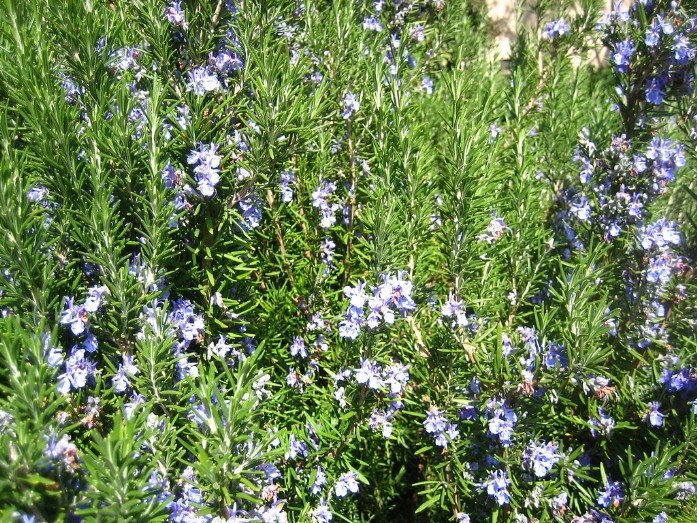Rosemary
Herbs A-Z > Know your herbs
Rosemary - Rosmarinus officianalis

Rosemary - Rosmarinus officianalis
Rosemary is a woody, perennial shrub with fragrant, evergreen, aromatic needle-like leaves, bearing white, or (usually) mauve flowers in the leaf axils, and is native to the coastal Mediterranean region, as are others in the Lamiaceae tribe – oregano, mint, thyme, basil and lavender. The binomial name Rosmarinus comes from ‘ros’ meaning dew and ‘marinus’ meaning sea – “sea-dew”.
The plant is semi-evergreen, that is, it sheds senescent leaves throughout the year and also produces new leaves. Hence even in winter, it is possible to harvest rosemary. The flowers appear from May until September.
The uses of rosemary are many, both medicinally and culinary. Culpeper notes its value in no less than twelve conditions, ranging from the common cold to consumption (TB), muscle pains and memory loss.
Rosemary can be decocted as an oil to rub on skin and hair, or used in the bath, in soap, or in hot lamps. The leaves when dried can be made into tea, or powdered and used in poultices (wraps).
Rosemary as food
Rosemary has been used not only to flavour food, particularly lamb and chicken, and in garlic with roast potatoes, but also to help preserve meat, as it reportedly has antimicrobial properties.
Rosemary as medicine
Traditionally rosemary has been used to alleviate muscle pain, improve memory, boost the immune and circulatory systems and promote hair growth. In Germany it is used as part of a treatment for dyspepsia and in Japan trials have show that Rosemary may significantly slow brain aging. Other studies have found it can also reduce age-related eye diseases such as macular degeneration.
Rosemary should not be used as a medicine alongside anti-coagulants or drugs used for regulating blood pressure.
Properties of rosemary
Rosemary has been found to be antibacterial and antiseptic. It is a good source of iron, calcium and Vitamin B6 and is rich in anti-oxidants. One rosemary oil component, carnocic acid, has been shown to correlate with improved cognitive performance, lending weight to the claims for its use in improving memory.
Notes on the cultivation of rosemary
Rosemary is best grown from soft cuttings taken in spring. These should be set into seed compost and kept indoors for 8-10 weeks. Alternatively rootlets will grow from cuttings placed in warm water, after which you can plant out in a dry sunny spot that is free-draining, even quite stony. The plant does not require feeding, but it should be regularly harvested to prevent a lanky, woody appearance. Prune out thick stems after flowering.
